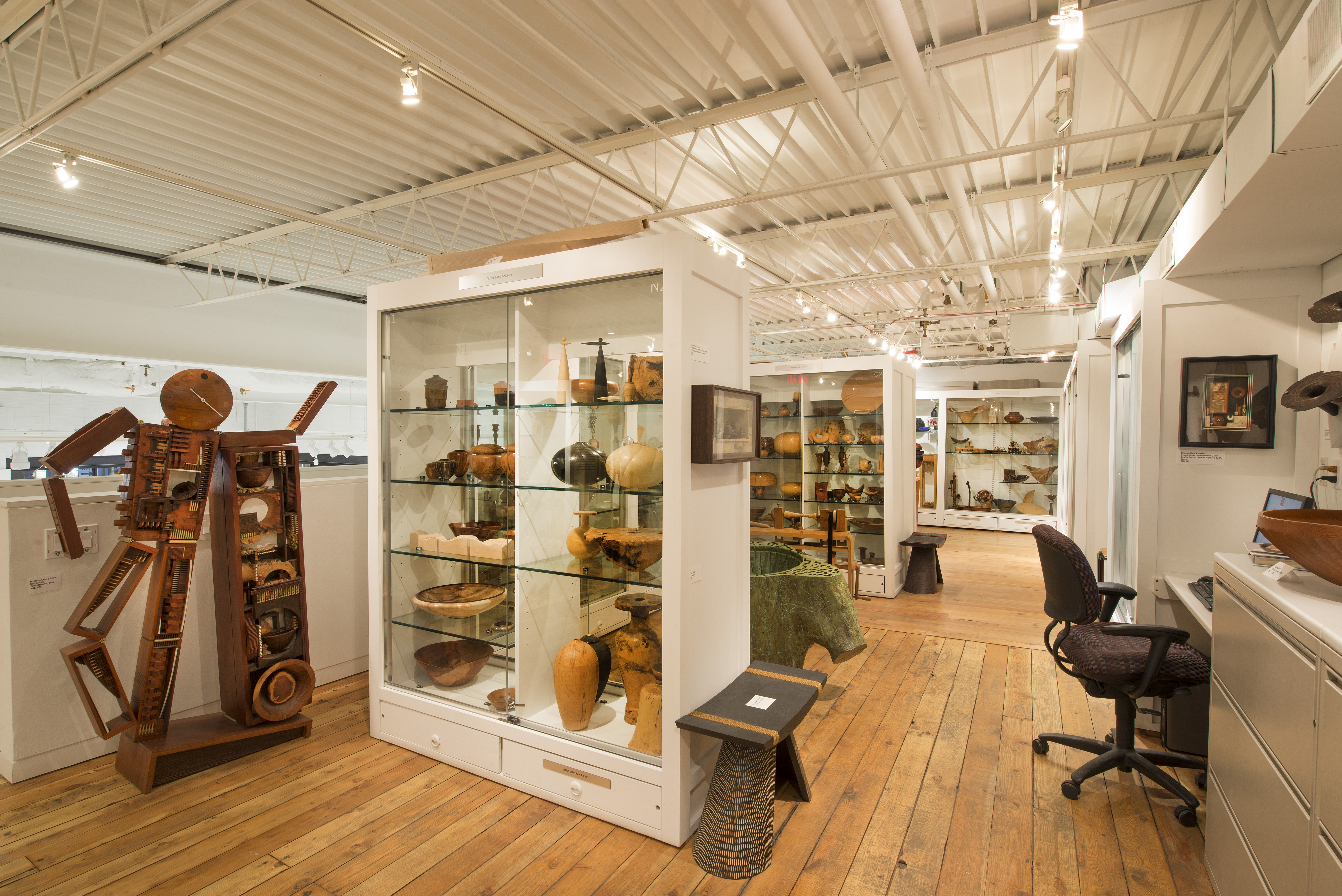Visiting Fellowship at the Center for Art in Wood
This semester, Trent Rhodes and I completed a visiting fellowship at the Center for Art in Wood in Philadelphia. The Center has been on the forefront of this exciting art field for forty years. The first floor is a changing gallery space that features innovative contemporary artists working in a variety of mediums. The second floor houses the Center’s permanent museum collection, an encyclopedic group of objects that documents the vibrant history of the field.
Image: A mural on the exterior of the Center’s building in Old City, Philadelphia feature silhouettes of objects from the permanent collection. Photo courtesy the Center for Art in Wood.
Our goal was to make the second floor museum space more engaging and accessible, ultimately enhancing visitor experience and appreciation for contemporary art in wood.
Currently, the permanent collection is in open storage, which allows visitors to reach their own conclusions and survey the remarkable collection in its entirely. However, having no text means that many visitors are left with unanswered questions, and visitors less experienced with contemporary wood art may feel overwhelmed or unequipped to appreciate the vast array without curation.
 Iamge: A portion of the second floor gallery space with the permanent collection displayed on various shelves in open storage, before our changes implemented in the Fall 2017 semester. Photo courtesy the Center for Art in Wood.
Iamge: A portion of the second floor gallery space with the permanent collection displayed on various shelves in open storage, before our changes implemented in the Fall 2017 semester. Photo courtesy the Center for Art in Wood.
Working with co-founder and Executive Director Albert LeCoff, we decided to re-install portions of the permanent collection to meet these goals. We then spent time learning about the Center’s history and collections. As we read through artist files, interviewed Albert, scoured the Center’s library, and of course spent time with the remarkable collection, themes rose to the surface.
Image: Fellows Trent Rhodes and Candice Roland Candeto (Class of 2018) conduct research in the The Fleur & Charles Bresler Research Library at the Center for Art in Wood.
We selected two centrally-located cabinets to curate with objects, text, and images–the first telling the history of the field and the Center’s role in it, and the second outlining five themes that run through the permanent collection and provide visitors with tools to better understand and appreciate art in wood. We wanted to maintain the endless possibility and unobtrusive quality provided by the open storage, so for the rest of the space we simply selected about one object per cabinet to feature with a small label, telling a short and engaging story to help bring the collection to life.
 Image: One of the newly installed cabinets, featuring objects Trent and Candice chose to tell this history of the field of woodturning and art in wood, awaiting printed labels and design elements.
Image: One of the newly installed cabinets, featuring objects Trent and Candice chose to tell this history of the field of woodturning and art in wood, awaiting printed labels and design elements.
Trent and I have now written near forty object labels and installed the final objects in their respective places, carefully balancing aesthetics with storytelling to best highlight each object and communicate to visitors. With our design proposal off to the graphic designer, we anxiously await the final stage: printing and installing our labels, then receiving visitor response to the newly curated space.
Image: One of my favorite pieces from the Center for Art in Wood, Emil Milan’s Double Grouse (2015.02.01.001), will now be featured in one of our introductory cabinets. Milan used the natural grain of the wood to create the birds’ tail feathers. Photo courtesy the Center for Art in Wood.
This opportunity allowed Trent and me to gain valuable experience with all aspects of curating an exhibition, including researching, choosing objects, writing labels, design, and programming. I benefited tremendously from this practical experience with exhibitions from the planning phases to installation, as well as the exposure to the fascinating world of contemporary art and craft.
Although the objects we were working with generally dated from 1970 or later, the collection had surprising resonance with our education at Winterthur. Working with these objects gave me a deeper appreciation for wood as a material, with new understanding of how various species behave and how different techniques impact surface appearance–all of which will translate to my thesis work on nineteenth century furniture. In addition, questions about the boundaries between art and craft are central at the Center for Art in Wood, and certainly inform my study of older decorative arts as well.
Check back in January on Winterthur Program in American Material Culture social media to see how the exhibition shapes up– or better yet, visit the Center for Art in Wood for yourself!
Thanks to Tom Guiler for overseeing our work this semester!
By Candice Roland Candeto, WPAMC Class of 2018




Your work really improved initial visitor orientation to the collection. Thanks for your weeks of dedicated scholarship and fresh insights.
Milan’s double grouse is a favorite of mine, which is why we gave it to the Center—so others could see it too. Milan had an amazing ability to “paint” details (wings, tailfeathers) using just heartwood/sapwood contrast. Thanks for selecting and promoting this piece! Craig